NGC 2194 is an intermediate open cluster in the Orion constellation, estimated to be 330 million years of age. It was discovered by William Herschel on February 11, 1784. It’s close proximity to the celestial equator allows the cluster to be visible from both hemispheres in certain times of the year.
In order to study and analyze the relationships between the colours, brightnesses, age and chemical composition of the cluster, NGC 2194, I carefully carried out a numerous amount of investigative steps using various software.
To begin, I collected 5 images in B filters with exposure lengths of 70.87s, 5 images in R filters with exposure lengths of 19.69s, and 5 images in V filters with exposure lengths of 31.5s. All images were taken using Skynet with the Prompt 6 telescope located in Cerro-Tololo. Next, I used Afterglow to create a tri-colour cluster image and photometer my stacked images. The color images I created are below.
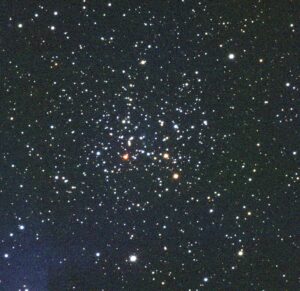
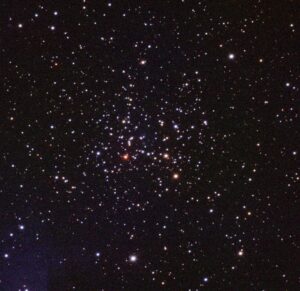
I used the batch photometry data from Afterglow to create an isochrone model in the Cluster Astromancer website. To do this, I uploaded my sources found in Afterglow, fetched all data for NGC 2194 from 4 catalogs (GAIA, 2MASS, APASS, and WISE), and went through many rounds of field star removal. Once I narrowed down the cluster stars and field stars, I was able to use the Isochrone Matching feature on Cluster Astromancer to estimate the proper motion in RA and Dec., distance, log(age), metallicity, and E(B-V) values. With this data, I created HR diagrams of my star cluster and fit the isochrone model to the data I collected. The graphs I created for my analysis were RP vs. BP-RP (figure 3), H vs. J-H (figure 4), R vs. B-R (figure 5), and V vs. B-V (figure 6). The parameters I estimated are in the following table.
| RA (°) | Dec. (°) | Proper Motion RA (mas/yr) | Proper Motion Dec. (mas/yr) | Distance (kpc) | Age (Myrs) | Log(age) | Metallicity (solar) | E(B-V) (mag) |
| 93.43 | 12.81 | 0.49 | -1.44 | 3.29 | 630.96 | 8.8 | -0.25 | 0.48 |
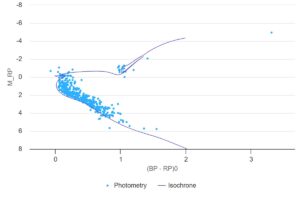
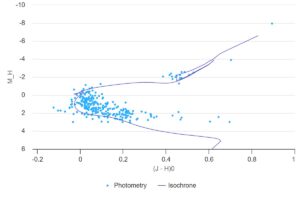
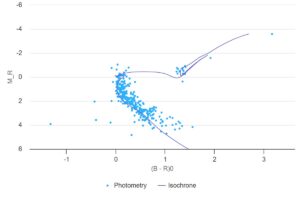

The next step in my analysis was to compare my estimated parameters with the parameters listed in the Milky Way Star Clusters Catalog (MWSC). I went back to Isochrone Matching in Cluster Astromancer and made a RP vs. BP-RP diagram (figure 7) and a H vs. J-H diagram (figure 8) using the MWSC parameters. The values from the MWSC are listed in the table below, followed by diagrams made using these values.
| RA (°) | Dec. (°) | Distance (kpc) | Log(age) | Metallicity (solar) | E(B-V) (mag) |
| 93.442 | 12.818 | 2.804 | 8.8 | 0 | 0.5 |
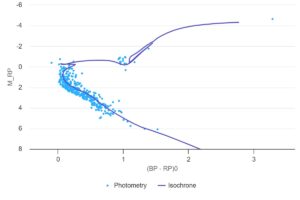
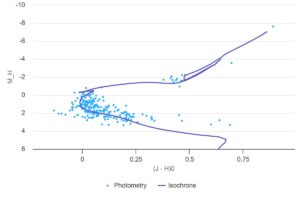
Once I had the above diagrams, I compared them with the diagrams I created with my estimated parameters. I was pleased to see that my log(age) value was the same. My proper motion RA and Dec. were within 0.01° of the MWSC’s values and the difference between the two E(B-V) values is only 0.02. However, my distance estimate was 0.486 kpc more than the MWSC distance. My metallicity value was 0.25 less than the MWSC metallicity value.
Looking at figure 1, the isochrone model seems to hug the bottom, most dense population of the data. In contrast, figure 5 shows the MWSC isochrone model hovers above the most dense area of the data plots. I believe these visual differences represent the difference of distance values. On the other hand, figure 6’s isochrone model seems to fit better than figure 2’s. This could be due to the difference in metallicities.
During this analysis of NGC 2194, I found blue stranglers and red giants. My estimates were very close which leads me to believe my findings further improve the accuracy and reliability of the MWSC parameters for proper motion RA and Dec., log(age), and E(B-V).
Taking everything into consideration, I am glad to have had this research experience. This was a great opportunity to test my knowledge and skills. Along the way, I learnt many things, and enjoyed it all, but to be honest, my favourite part was creating my colour images. It fascinates me and makes me curious about what else there is to see and discover in the universe. I hope to continue expanding my astronomy knowledge and skills in the future.